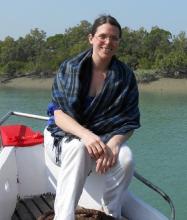Global wave modelling
We will contribute to COWCLIP – The Coordinated Ocean Wave Climate Project "The Coordinated Ocean Wave Climate Project (COWCLIP) is an international collaborative research project, being a component of the work-plan for the JCOMM Expert Team on Waves and Coastal Hazards."
Example movie of surface waves travelling across the global ocean

UK Coastal Hazards: Multi-hazard controls on Flooding and Erosion (CHAMFER)
Combining the risks from marine, fluvial, and terrestrial flooding with erosion and coastal vulnerability
EcoWind-ACCELERATE
Ecological implications of accelerated seabed mobility around wind farms
How will the placement of offshore wind infrastructure combine with the climate crisis to impact the seabed and beyond?

FOCUS: Future states Of the global Coastal ocean: Understanding for Solutions
2021-2030 is the UN Decade of Ocean Science for Sustainable Development (UND) aiming at “The
science we need for the ocean we want”. In FOCUS we propose a multidisciplinary programme of
research to contribute to the goals of UND, building fundamental understanding and unifying
principles where challenges of global change in the coastal ocean are most acute, and to develop
and strengthen scientific partnerships to both enhance our capabilities and deliver international
science impact at the highest level.

image: combined coastal vulnerability around the Caribbean Seas
Climate Linked Atlantic Sector Science (CLASS)
CLASS capitalises on current and past National Capability and strategic programme outcomes to address four key knowledge gaps related to ocean variability, biodiversity and resultant functional capacity of the Atlantic

https://noc.ac.uk/projects/class
RASCALs: Subsea cables Adaptation and Resilience Scoping project
Rapid evidence assessment of the marine stressor to the global telecommunications network, using existing wave and seabed
current data to assess past and present resilience, and adaptation strategies for the future.

Image: typical wave height experienced around location of global subsea telecoms cable network
Salt intrusion: Understanding the Pearl River Estuary by Modelling and field Experiments (SUPREME).
EPSRC Reference: EP/R024480/2.

Image: FVCOM model resolution for Pearl River configuration
Addressing Challenges of Coastal Communities through Ocean Research for Developing Economies (ACCORD)
ACCORD is funded by the Natural Environment Research Council (NERC) as part of a National Capability, Official Development Assistance award (NC-ODA). The research programme is delivered jointly by the NOC and the Plymouth Marine Laboratory (PML).
Understanding freshwater budgets and salt intrusion in the Bangladesh delta, for water security under climate change

image: rice harvest on the Ganges-Brahmaputra-Meghna delta

Image: impact of changing river salinity on rice growing seasons
National Partnership for Ocean Prediction
This Working Group provides a focus on the observation, modelling and forecasting of ocean surface waves, in the global ocean and regional domains, particularly in the shelf-seas and coastal areas.
https://oceanprediction.org/activity-groups/surface-waves/
Commonwealth Marine Economies Programme
Enabling safe and sustainable marine economies across Commonwealth Small Island Developing States
https://projects.noc.ac.uk/cme-programme/

Image: swell waves on St Vincent
ESPA Deltas: Ecosystem services for poverty alleviation
This project involved producing hydrodynamic modelling (using FVCOM) for Bangladesh, concentrating on the Ganges-Brahmaputra Delta. The physical modelling will be combined with fisheries, river and land-use models.
https://www.espadelta.net

image: model grid and water depth around Northern Bay of Bengal
Rises AM: Responses to coastal climate change: Innovative Strategies for high End Scenarios – Adaptation and Mitigation

image: downscaled mean wave climate from global to regional model
Forecasting the future wave climate around Europe in collaboration with UPC and HZG. The FP7 EC commissioned Rises AM project was designed to assess coastal vulnerability to waves around North West Europe. For Rises I have generated a 223 year data set describing the global wave climate, and an equivalent downscaled European data set at very high resolution for future climate scenarios representing a range of high-end sea level rise projections. These outputs will inform coastal flood risk projections (following on from UKCP09), and help us understand the impacts of dynamical downscaling.

Image: Future change in mean annual maximum wave height - projection for end century under RCP8.5
https://www.risesam.eu
Field_AC: Fluxes, Interactions and Environment at the Land-ocean boundary. Downscaling, Assimilation and Coupling
Coastal scale modelling, downscaling, air-sea interaction and model coupling. This project is concentrating on 4 field sites; Liverpool Bay; The Catalan Coast; The German Bight and Venice Lagoon.
Coupled modelling is important way to improve physics at interfaces between the ocean/atmosphere/land. As part of the European FP7 Field_AC project (2010-2012), I developed a coupled modelling system, resulting in a pre-operational modelling tool for shelf seas. Combining atmospheric, hydrodynamic, wave, hydrological, ecosystem, and sediment transport models.

Image: Downscaled coastal currents off Barcelona
National Centre for Ocean Forecasting (NCOF) Waves working group
A special interest group combining expertise on surface waves from around the UK
Natural Sea Bed Disturbance
I developed the state-of-the-art POLCOMS-WAM model to inform CEFAS regarding seabed disturbance around the English Channel / Southern North Sea. This project produced a climatological wave and current data for the entire UK continental shelf from 1999–2008.
The ten year hindcast reflects wave and surge climate, together with sea bed conditions, wave and current generated bottom disturbances. This 13km resolution data has recently been published through BODC, and is available for download here:
https://www.bodc.ac.uk/data/
